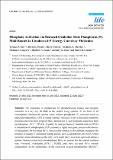Phosphate activation via reduced oxidation state phosphorus (P). Mild routes to condensed-P energy currency molecules
Abstract
The emergence of mechanisms for phosphorylating organic and inorganic molecules is a key step en route to the earliest living systems. At the heart of all contemporary biochemical systems reside reactive phosphorus (P) molecules (such as adenosine triphosphate, ATP) as energy currency molecules to drive endergonic metabolic processes and it has been proposed that a predecessor of such molecules could have been pyrophosphate [P2O74−; PPi(V)]. Arguably the most geologically plausible route to PPi(V) is dehydration of orthophosphate, Pi(V), normally a highly endergonic process in the absence of mechanisms for activating Pi(V). One possible solution to this problem recognizes the presence of reactive-P containing mineral phases, such as schreibersite [(Fe,Ni)3P] within meteorites whose abundance on the early Earth would likely have been significant during a putative Hadean-Archean heavy bombardment. Here, we propose that the reduced oxidation state P-oxyacid, H-phosphite [HPO32−; Pi(III)] could have activated Pi(V) towards condensation via the intermediacy of the condensed oxyacid pyrophosphite [H2P2O52−; PPi(III)]. We provide geologically plausible provenance for PPi(III) along with evidence of its ability to activate Pi(V) towards PPi(V) formation under mild conditions (80 °C) in water.
Citation
Kee , T , Bryant , D , Herschy , B , Marriott , K , Cosgrove , N , Pasek , M , Atlas , Z & Cousins , C R 2013 , ' Phosphate activation via reduced oxidation state phosphorus (P). Mild routes to condensed-P energy currency molecules ' , Life , vol. 3 , no. 3 . https://doi.org/10.3390/life3030386
Publication
Life
Status
Peer reviewed
ISSN
2075-1729Type
Journal article
Description
The authors thank the EPSRC (grant EP/F042558/1), the Leverhulme Trust (grant F07112AA), the STFC and the UK Space Agency (Aurora Fellowship to TPK).Collections
Items in the St Andrews Research Repository are protected by copyright, with all rights reserved, unless otherwise indicated.

